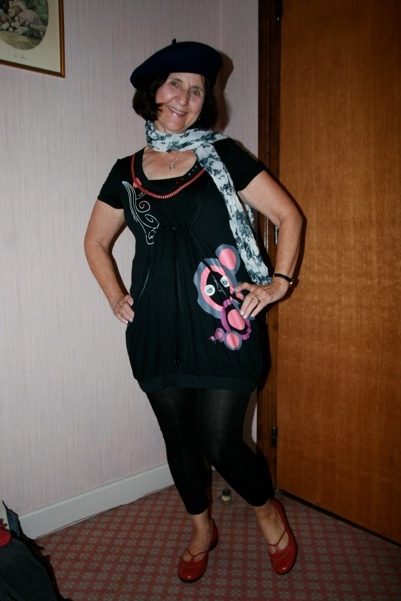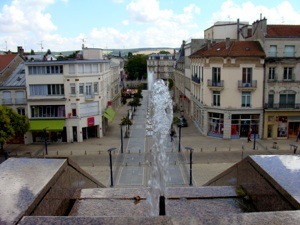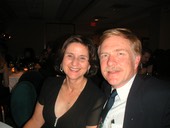The pictures above is looking at the Memorial to Victory in Verdun. Our hotel is just on the right (you can see part of the sign (le Har...). Verdun is a very nice little town, which is famous, or perhaps infamous, for being the site of the bloodiest battle in history (in terms of number of people killed per unit area). More about that later. We had a leisurely morning, which as usual included café au lait and a pastry. This time it was beignet. Then we explored the town and Caroline did some shopping. We found the tourist information center and booked tickets on a bus tour of the major sites in the Verdun battlefield.
We walked up to the Memorial to Victory and got a nice view of the city.

Verdun was the closest town to a major battle in WWI. After a simple lunch, we headed for the bus and the tour of the battlefields monuments.

The good thing about the tour was the English commentary on headphones and the English captions in the museum we visited. Something like 300,000 soldiers where killed during the 100 days of hell that lasted from mid February to October 1916. The area of the battlefield was about 10 square miles. Something like 2,000,000 artillery shells were fired by the Germans on the fist day of the battle and 60,000,000 shells were fired over the 100 days. That is staggering. The battle field was chewed up by the artillery shells to a depth of several meters and the ground still shows the effects of that. (We plan to stop there tomorrow). It is hard to overstate how terrible it was for both the French and the Germans. To top it off, the battle was not a high priority for the French army. They were focused on an offensive near Somme. Somehow the battle raged on and on and on, and after 100 days, there was no clear winner, only 300,000 men who lost their life.
On of the interesting side stories is that the soldiers in the trenches were mostly men who were used to working with their hands. During their down times, they took whatever they could find and made things that they could use, or souvenirs, or actual art.

This is a picture of an artillery shell that has been turned into an art object. The picture does not do it justice. The work is intricate and detailed, and the piece is quite beautiful, in a horrific sort of way. WWI was a tremendous bloodbath for the Europeans. Something like 8,000,000 men were killed during the war on both sides. That is staggering.
We spent the rest of the day wandering around the town, and doing some shopping. Chuck found a gorgeous French woman and took her to dinner.

Life is good!


